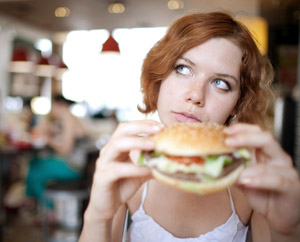Snacking and Portion Size a Key Factor in Weight Control

Decades of data on food and calorie intake
The study, published in the Public Library of Science’s journal PLoS Medicine, looked at data from large food surveys done in the US since the 1970s:
- the Nationwide Food Consumption Survey (1977–78),
- the Continuing Survey of Food Intakes of Individuals (1989–91, 1994–96, and 1998), and
- the National Health and Nutritional Examination Survey (2003–06).
Researchers aimed to identify the relative contributions of increased calorie density of foods, increased portion sizes, and increased number of eating occasions (meals and snacks) per day on the increase in total daily calorie intake over the decades.
Bigger snacks the biggest culprit
Changes in calorie density of foods had little effect on total daily calorie intake during the 30-year study period. The following were much more influential:
- Total calorie intake went from about 1,800 calories per day in 1977 to 2,400 calories per day in 2006—a 33% increase!
- Increasing portion sizes was the biggest contributor to the change in calorie intake from 1977 to 1991, responsible for an additional 15 calories per day each year, while an increase in number of meals and snacks added only 4 calories per day each year.
- A rising number of meals and snacks accounted for most of the increase in calories in the 1994 to 2006 period, adding 39 calories per day each year, while changes in portion sizes decreased the total daily calorie consumption by 1 calorie each year.
“These findings suggest that efforts to prevent obesity among US adults (and among adults in other developed countries) should focus on reducing the number of meals and snacks people consume during the day,” the study’s authors said.
Shift the calorie balance to lose weight
The only way to lose weight is to burn more calories than you take in, so the best way to shift the balance toward weight loss is to reduce your calories and boost your physical activity. Based on these findings, one place to look for extra calories to cut is in your snacks. Here are some strategies for reducing snacking:
- Eat enough at mealtimes. No need to overeat, but make sure you eat enough to hold you until your next meal.
- Make your meals nourishing. Despite the lack of influence described above, other research has found that nutrient-dense foods satisfy hunger for longer than less nutritious foods.
- Try going for a walk before snacking. A little physical activity can curb your appetite and help you put off eating.
- Make sure you have healthy snacks available. Keep raw fruits and vegetables handy for times when you just want to eat, and nuts or seeds around for times when you are truly hungry.
(PLoS 2011;8:e1001050)
Copyright © 2024 TraceGains, Inc. All rights reserved.



 We are proud to announce that
We are proud to announce that  As the market evolves, customers increasingly request a wider variety of omega-3 options for their lipid...
As the market evolves, customers increasingly request a wider variety of omega-3 options for their lipid...  Maintaining healthy glucose levels is crucial for preventing metabolic conditions like diabetes,...
Maintaining healthy glucose levels is crucial for preventing metabolic conditions like diabetes,...  Looking at formulating a new vitamin blend? Discover
Looking at formulating a new vitamin blend? Discover 







































